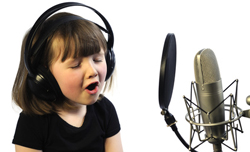 When you record your voice, are you happy with the result? Well, let me ask it a different way because a lot of people simply hate the way their voice sounds to them when they hear it played back on a recording, regardless of the audio quality. That’s a different thing. I’m referring to whether the sound is nice and clear without a lot of noise in the background.
When you record your voice, are you happy with the result? Well, let me ask it a different way because a lot of people simply hate the way their voice sounds to them when they hear it played back on a recording, regardless of the audio quality. That’s a different thing. I’m referring to whether the sound is nice and clear without a lot of noise in the background.
A lot of people don’t really know if their voice sounds “good” or not. If they can be understood and heard by others, they feel it is good enough. And it may be good enough for what you’re doing! I mean, if all you want to do is chat with family and friends over Skype or some other internet meeting, it may not be all that important that your voice sound “professional.”
But if you are recording your voice for any kind of business reason, such as for podcasts, videos, or voice-overs, then it might be time to listen critically to a recording of your voice and assess it for how professional it sounds. Is there a lot of hiss or other types of noise in the background? Maybe the audio is “thin” sounding? Heck, even then you might not hear anything wrong! I have a friend who is a successful internet marketer, video-blogger, and podcaster. She had no idea that her audio sounded bad enough that it made her sound like an amateur. It wasn’t until someone recorded her with a decent microphone that her eyes were opened (maybe the metaphor here should say “ears were opened,” but I digress). she didn’t realize how bad her voice sounded until she heard how it COULD sound with the right equipment – in her case, just a slightly better microphone.
The Microphone

Notice I said “slightly better microphone” above. When people think of home studio microphones the often think expensive, assuming they will have to spend hundreds or even thousands of dollars. My friend was using a USB headset mic costing about $35. Someone recorded her voice with a microphone costing only about $100 called the Blue Yeti, which is also a USB mic, meaning all you have to do is put it on your desk and plug it into your computer. No mixers or interfaces are involved. Anyway, when she heard playback of her voice recorded on the Yeti, she was stunned! “Oh my god,” she said. “I had no idea.” For only about $75 more than the headset mic she was using, her voice went from sounding “OK” to “Oh my god.”
The Yeti is a good microphone, but the good news is that my friend could have gotten the “oh my god” reaction with an even less expensive USB mic such as the Samson C01U, which you can pick up at your local Best Buy store for around $75 (only a $40 difference from “OK” to “oh my god” this time).
 The main reason the Yeti and the Samson C01U mics sound so much better than the headset type mic is the size of the microphone element or diaphragm inside. The bigger mics are called “large diaphragm condenser” mics. There are other differences as well, such as the fact that headset USB mics are usually dynamic type mics which are typically less sensitive than condenser mics. But you probably don’t care much about that.
The main reason the Yeti and the Samson C01U mics sound so much better than the headset type mic is the size of the microphone element or diaphragm inside. The bigger mics are called “large diaphragm condenser” mics. There are other differences as well, such as the fact that headset USB mics are usually dynamic type mics which are typically less sensitive than condenser mics. But you probably don’t care much about that.
What is important is that if you need to record your voice and have it sound professional, a really smart way to make that happen quickly and easily (not to mention cheaply) is simply to use a large diaphragm condenser (LDC) type USB mic. There are many levels of “OMG” above even that of course, which involve different kinds of microphones at higher cost. But for most people, the upgrade to an LDC USB mic for less than $100. It is a small price to pay for professional quality voice audio.
I’d love to hear some before-and-after audio if you decide to make this change. Send in a comment below and maybe we can post some examples.
Cheers – and happy recording!
 “Home recording for non-engineers” is just my way of saying that it does not have to be hard or expensive for just about anyone to do it.
“Home recording for non-engineers” is just my way of saying that it does not have to be hard or expensive for just about anyone to do it.
 To mix music down means to combine several tracks of audio into a single file when doing multi-track recording. The term “render” means the same thing. It’s actually more often used these days in many audio software programs.
To mix music down means to combine several tracks of audio into a single file when doing multi-track recording. The term “render” means the same thing. It’s actually more often used these days in many audio software programs. is combines the output of all your tracks, at their current volume relative to the other tracks, into one audio output. It’s like putting lots of things (like 5 audio files) into a funnel, and having only thing (wav or mp3 file) that is a mixture of the 5 sources come out the small end. See the picture on the right, which pretty much sums up (no pun intended…OK, pun intended) mixing down.
is combines the output of all your tracks, at their current volume relative to the other tracks, into one audio output. It’s like putting lots of things (like 5 audio files) into a funnel, and having only thing (wav or mp3 file) that is a mixture of the 5 sources come out the small end. See the picture on the right, which pretty much sums up (no pun intended…OK, pun intended) mixing down. This is Part 2 in the series
This is Part 2 in the series The following is a list of 5 really important things about audio recording that would have made my life soooo much easier if I had known them when I started with my first home recording studio. Hopefully this article will be of great benefit to you if you want to learn home recording. This is part 1 in a series.
The following is a list of 5 really important things about audio recording that would have made my life soooo much easier if I had known them when I started with my first home recording studio. Hopefully this article will be of great benefit to you if you want to learn home recording. This is part 1 in a series.